Whether you’re ready to get started or would like to know more, we’re here to help.
By Sam Charlwood, carsales.com.au
Electric cars have turned a corner and are now selling in record numbers. It’s taken more than a decade, since the Nissan Leaf arrived as one of the first mainstream EVs, for battery-powered vehicles to become front of mind and a legitimate choice for many prospective buyers.
Now, as the elder statesman of the EV class, Nissan has upgraded its second-generation Leaf hatchback in an attempt to keep pace with the latest wave of all-new high-tech rivals.
First to the party
Nissan was an early pioneer in the push to promote electric vehicles with its original, first-generation Leaf. While it never sold in big numbers, it was a vehicle clearly ahead of its time.
But a decade on from its arrival, as we navigate a renewed transition to electrification, Nissan’s groundbreaking electric car arguably lacks the currency and popularity that its foresight suggests.
As such, the Japanese brand has given its EV hatchback a mild update across the range as it continues to keep the candle burning before long-awaited new-generation EVs such as the Nissan Ariya SUV start to arrive in showrooms next year. The LEAF itself is also expected to transform into an SUV by 2025.
As facelifts go, this one’s pretty minor, so let’s see what Nissan’s boffins have achieved.
Higher prices
The two-model Nissan Leaf (MY23) range costs slightly more before, with the standard version now starting at $50,990 plus on-road costs while the more powerful, longer range Leaf e+ costs $61,490 plus ORCs.
Those prices each represent a $1000 increase over the previous respective model and are reflected by marginally more equipment.
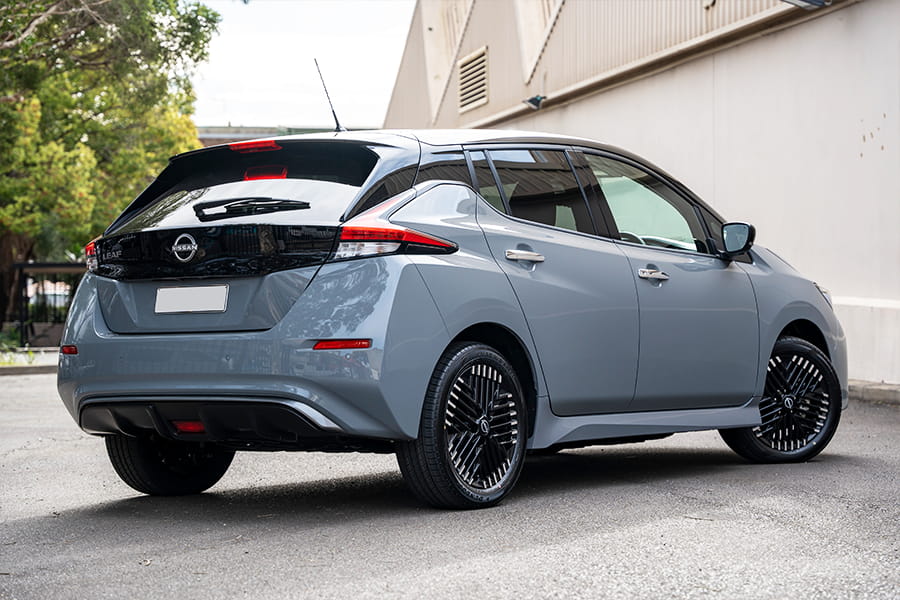
There’s a new switchable digital rear-view mirror and a ‘Canto’ pedestrian warning sound system, which operates between 0-30km/h to alert walkers of the Leaf’s presence and movement.
There’s also a styling update which revolves primarily around redesigned 17-inch alloy wheels, darkened headlight trims, refreshed badging and a tweaked grille design. Nissan claims the revisions make the Leaf appear more refined and dynamic.
Those changes are in addition to carryover items such as low-rolling-resistance tyres, privacy glass, heated electric fold-in mirrors, auto on/off LED headlights with high beam assist, climate control, auto-dimming rear-view mirror, rain-sensing wipers, keyless start, adaptive cruise control, leather-accented upholstery, front seat heating and a 60/40-split folding rear seat.
There’s Apple CarPlay and Android Auto functionality via a cable and the 8.0-inch colour touch screen display is home to sat-nav and a seven-speaker Bose audio system with DAB+ digital radio.
Passive safety items fitted to the Leaf e+ include six airbags – dual front airbags, side-impact thorax-protecting airbags (on the front seats) and head-protecting curtain airbags for the first and second row – while driver assist technology includes all-round camera monitoring, front and rear parking sensors, driver fatigue monitoring, forward collision warning, autonomous emergency braking (AEB) with pedestrian detection, lane departure warning, lane keep assist, blind spot monitoring, rear cross traffic alert, tyre pressure monitoring, traffic sign recognition and audible warning for pedestrians (reverse and low-speed only).
The standard Leaf retains a five-star ANCAP safety rating that dates back to 2018, although this does not apply to the higher-output Leaf e+ model.
In terms of the ownership experience, Nissan provides a five-year/unlimited-kilometre warranty on the vehicle, while its battery is covered by a separate eight-year/160,000km warranty, which are both par for the course.
Servicing intervals are set every 12 months/20,000km, with an annual service priced between $250 and $300, according to Nissan.
No Charge
No changes have been made under the updated skin, meaning the entry-level 2022 Nissan Leaf retains a 110kW/320Nm electric motor for propulsion, drawing current from a 40kWh lithium-ion battery.
Similarly, the 2022 Nissan Leaf e+ continues with an upgraded 160kW/340Nm motor with a larger capacity 64kWh battery.
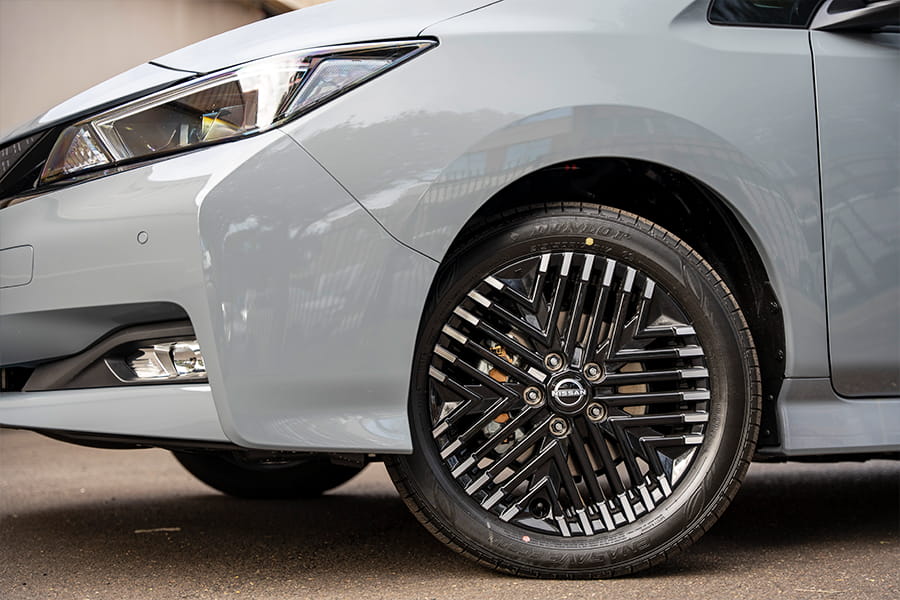
Despite the sleeker wheels and bodywork, neither variant brings an increase in driving range for the new model year, retaining their 270km and 385km (WLTP) ranges respectively.
According to Nissan, the Leaf e+ delivers a 0-100km/h time of 6.9 seconds.
Charging from 0-100 per cent from a domestic AC outlet takes 32 hours, while a more powerful 6.6kW AC charger reduces that time down to a much more palatable 11.5 hours.
Restoring charge from 20 to 80 per cent on a 50kW DC fast charger takes 90 minutes, according to Nissan.
Getting old
For all of its pioneering ways, there’s something we should tell you about the freshly facelifted 2022 Nissan Leaf e+. It’s starting to feel a little outdated.
That’s not a slight, or a preconceived criticism. It’s simply a fact.
Now well into its second generation, and with a replacement not on the horizon until mid-decade, Nissan’s EV simply cannot compete with the dazzling wares, big screens, range or performance of its modern contemporaries such as the Tesla Model 3 – which won carsales’ Best Electric Car for 2022 – and the Tesla Model Y, plus the Kia EV6 and Hyundai IONIQ 5.
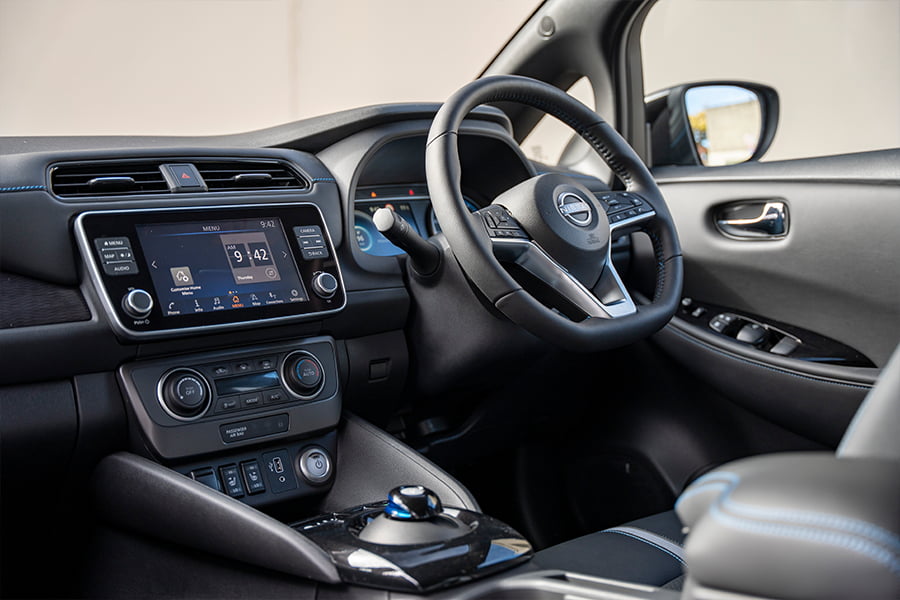
As such, jumping into the driver’s seat of the Leaf immediately presents as something of a throwback to its original launch in 2012 with antiquated elements such as a foot-operated park brake, a perched driving position (a virtue of the batteries underneath and the ageing platform) and no digital speedometer or reach adjustment on the steering wheel.
We’d be pointing all of this out and criticising these on a $20,000 city car, let alone a $60,000 EV – a vehicle segment that is supposedly about the cutting-edge tech. The Leaf e+ simply feels off the pace.
Moreover, the Leaf’s outward vision is impeded by bulky split front A-pillars and a narrow rear windscreen while the dashboard is festooned with all manner of buttons and switchgear.
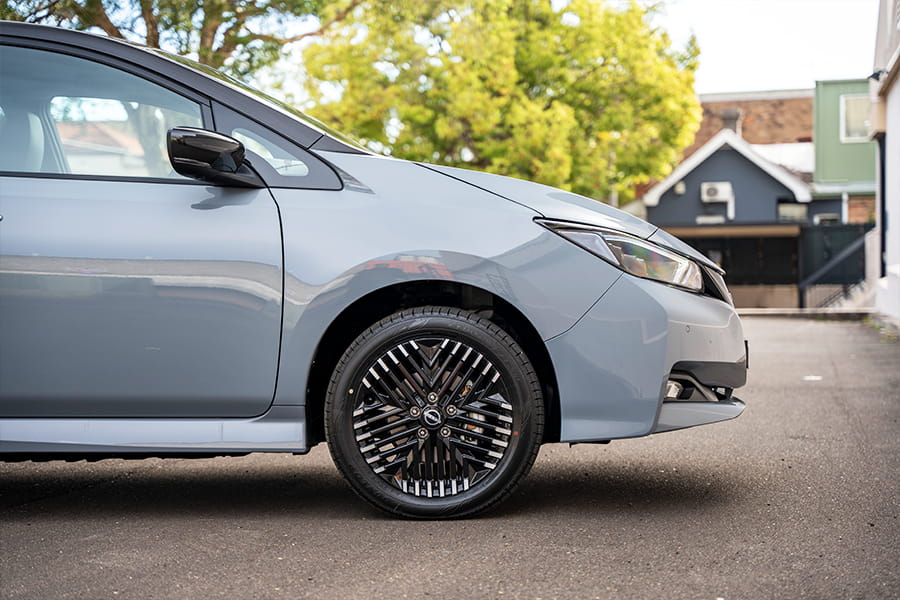
In terms of practicality, however, the Leaf e+ offers ample in-car storage, charging points and overall space given its 4.49-metre length.
The infotainment system is relatively inoffensive, too, with simple corded pairing to smartphone mirroring and a legible, easy interface.
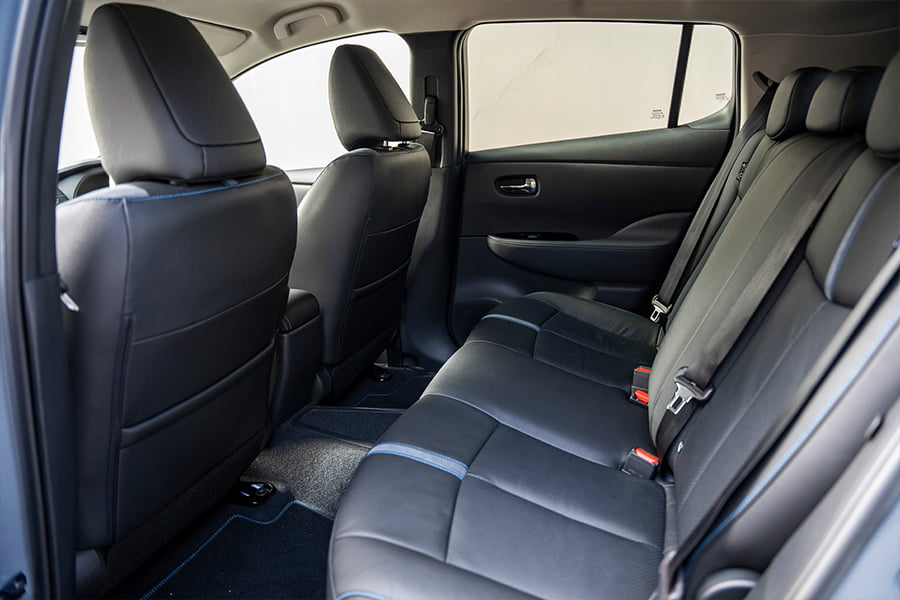
Further back, the second row happily accommodates two adults or children alike, serviced by rear seat heating and ISOFIX attachment points on the outbound pews. There are no rear air vents, though.
Likewise, the 405-litre boot area provides adequate proportions even with the fitment of a Bose sound box. The Leaf’s engine bay is occupied by electric hardware, and as a result, there is no additional ‘front trunk’ storage as there is in newer models built on dedicated electric car platforms.
On the road, the Nissan Leaf e+ again covers the basics, but even then, you cannot ignore its age.
The drive experience is initially telegraphed by a spongey brake pedal action and more pitch and roll in the corners than a lot of EV contemporaries. We’d bet the latter is again a virtue of the Leaf’s ageing platform, with its wheelbase and spread of weight paling against more modern and athletic rivals.
Otherwise, the Leaf e+ is sound rather than ground-breaking with its on-road skillset. The ride and handling mix does an admirable job of isolating occupants from what’s happening underneath, while also offering faithful body control through changes in direction.
Most road irregularities are dispatched effortlessly, but there are occasions where sharper obstacles will thud their way through the cabin.
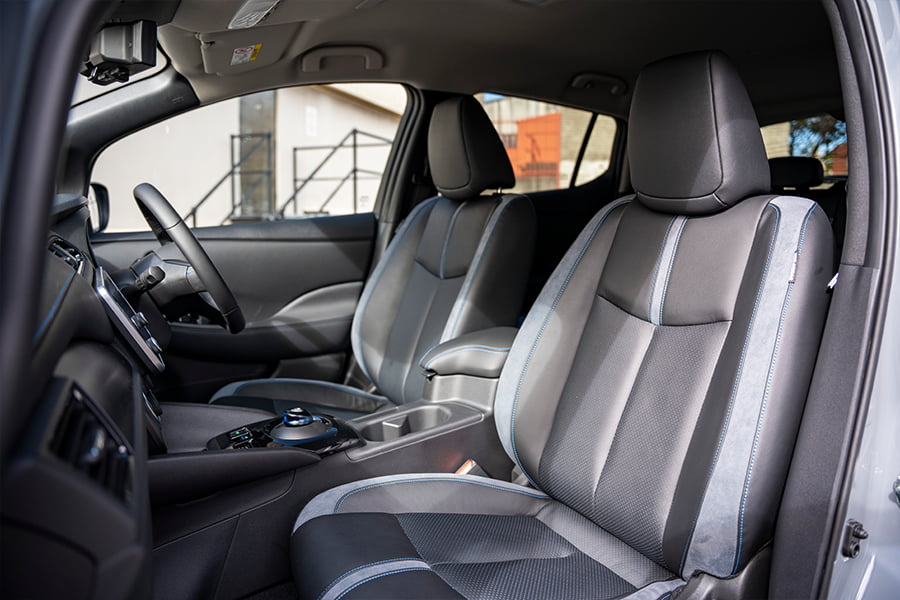
Power delivery from the electric motor is predictable and spritely, with ample shove from a standstill and a linear climb up the speedo when you ask for more urge.
In a city environment, the Leaf e+ never feels headed in terms of power and torque. And refinement is relatively strong too.
Based on our initial drive impressions – plus previous experience in the predecessor – we reckon a real-world range of between 300km and 320km is largely achievable in mixed conditions.
The game has changed
We owe a lot to the Nissan Leaf and its role in helping EVs gain mass-market acceptance in Australia.
Irrespective of that, there’s no escaping its age and the lack of sizzle around this ever-so-light facelift.
Sure, the 2022 Nissan Leaf e+ covers the basics and makes a reasonable case as an everyday ownership prospect.
But the EV game has also moved on in many respects – and consumers are increasingly wanting more without compromise.
How much does the 2022 Nissan LEAF e+ cost?
| Price: $61,490 (plus on-road costs) |
Battery: 62kWh lithium-ion |
| Available: Now |
Range: 385km (WLTP) |
| Powertrain: Single permanent magnet synchronous motor |
Energy consumption: 18.0kWh/100km (WLTP) |
| Output: 160kW/340Nm |
Safety rating: Not tested |
| Transmission: Single-speed reduction gear |
Disclaimer: Images supplied by carsales.
This article was prepared by an independent author. The information contained in this article represents the views and opinions of the original author, and is based on research carried out by the original author. The appearance of the article on Maxxia's website does not constitute an endorsement of its content by Maxxia in any way. The article has been made available for informational purposes only and should not be taken as advice. While all reasonable care has been taken to ensure that the statements made by the original author in the article are fair and accurate, Maxxia does not guarantee or warrant the accuracy or completeness of this information and will not be liable for, or in connection with, any loss or damage suffered as a result of any inaccuracies, errors or omissions or your reliance on this information. You should independently research and verify information before making any decision in respect of a vehicle.


